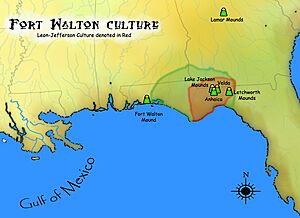Leon-Jefferson culture facts for kids
The Leon-Jefferson Culture is a name archaeologists use for a group of Native American people who lived in southeastern North America. They thrived from about 1500 to 1704 CE. This culture is connected to the historic Apalachee people. It is named after the present-day Leon and Jefferson counties in northern Florida of the Southeastern United States.
A Look at Their History
The Leon-Jefferson Culture developed from an earlier group called the Fort Walton Culture. This change might have happened because of contact with people from central Georgia, known as the Lamar Phase. During this time, the way people made and decorated their pottery changed. New styles from central Georgia became part of the local traditions.
This period also saw big changes for the Apalachee people. Their large communities began to shrink after they met European explorers and settlers. Early in this period, larger settlements appeared, possibly due to new people arriving. These settlements were often in typical Fort Walton places, like near hills and close to water sources such as ponds and lakes.
Later on, the number of people started to drop. This was likely because of diseases brought by Europeans. For example, the explorer Hernando de Soto passed through the area in 1539. By the time of the Spanish Mission Period, villages were smaller and often built around mission churches.
| Period | Dates |
|---|---|
| Weeden Island Culture | 400-500 - 1200 CE |
| Fort Walton Culture | 1200 - 1500 CE |
| Leon-Jefferson Culture | 1500 - 1704 CE |
| Spanish Mission Period | 1633 - 1704 CE |
| Creek-Seminole | 1704 - 1850 CE |
Pottery and Art
In the early Leon-Jefferson period, people made very good pottery. They used grit (small pieces of rock or sand) mixed into the clay to make it stronger. This was different from many other Mississippian culture groups, who often used crushed mussel shells.
Around 1450 CE, unique stamped and carved pottery from central Georgia started appearing in the Apalachee area. This probably shows that they traded or had alliances with powerful groups in central Georgia. These groups were centered around the Lamar Mounds and Village Site, which is now part of the Ocmulgee National Monument.
By about 1600, local potters were making pottery in the Lamar style. However, they still used their own local clay and grit for tempering. The most common pottery shapes were bowls with rims that flared outwards, similar to Lamar styles. As time went on, the quality of the pottery became less detailed.
Where They Lived
Like other Mississippian peoples, the Leon-Jefferson people had organized settlements. They built ceremonial platform mounds, which are large, flat-topped hills made by hand. They also grew a lot of maize (corn) for food.
Anhaica, located near the city center of Tallahassee, was the main town of the Apalachee region. The Lake Jackson site, about 3 miles north of Tallahassee, was an important Fort Walton period site. It was also a major place connected to the Southeastern Ceremonial Complex, a network of shared beliefs and practices among ancient Native American cultures.
The northwest Florida region also includes the Letchworth Mounds in Jefferson County. This area generally stretches from the Ochlockonee River east to the Aucilla River in the Florida Panhandle. Often, there were cultural differences between groups who lived inland and used resources from Leon and Jefferson counties, and those who lived near the coast and used coastal resources.


